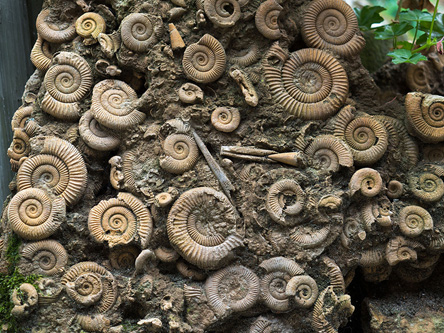
Credit: ermell, via Wikimedia Commons (CC BY-SA 3.0 [http://creativecommons.org/licenses/by-sa/3.0]).
99.9 percent of all known species that have ever existed on Earth are gone—extinct. Most of them disappeared in five great extinction events.
The first two happened several hundred million years ago. One was caused by a major ice age; the other, by falling oxygen levels in the world’s oceans.
The next big extinction, 250 million years ago, is called the Great Dying, because 96 percent of living species were wiped out. This one, and the one that followed at 200 million years, seem to have been triggered by a hotter climate.
There are many theories about what caused them, including meteorites, major lava flows, hydrate melts, and other climate events. Probably some of each.
One thing is consistent: dying species left empty environmental niches, which surviving species could then evolve to fill. In this way, these two extinctions allowed dinosaurs to dominate Earth.
Their rule lasted 200 million years, until volcanic activity started their decline. Then, around 65 million years ago, an asteroid famously hit Earth. Ash darkened the skies and plunged Earth into global winter, triggering the last great extinction.
Dinosaurs died off, and small animals with warm blood had a huge advantage. This gave rise to the age of mammals, and some of them, millions of years later, became you and me.
In this way, each extinction made it possible for new and often more advanced life forms to replace the old ones. Without that asteroid, we wouldn’t be here.
Background
Synopsis: Today, 99.9 percent of all species that have existed on Earth are extinct. Since the Cambrian explosion of life around 540 million years ago (Ma), there have been five mass extinction events that were caused by varied mechanisms: volcanism, asteroid impacts, ice ages, or massive algal blooms depleting ocean oxygen. All have been related to abrupt changes in Earth’s climate, but life evolved and flourished after each event.
- Overall, 99.9 percent of all species that have lived on Earth are extinct.
- There is always a background extinction rate, but there have been five mass extinction events recorded in the past 540 million years (since complex multicellular life developed in the Cambrian period) in which more than 75 percent of all species disappeared from Earth in less than 1 million years.
- The first great extinction occurred 444 Ma, at the end of the Ordovician period.
- About 86 percent of species living at the time became extinct as a result of a severe ice age, which lasted about 1 million years.
- It was probably triggered by a great mountain-building continental collision that exposed silicate rocks to erosion. This drew CO2 out of the atmosphere as the mountains weathered, reducing the greenhouse effect and chilling the planet.
- The second great extinction occurred in the Late Devonian, 375 Ma.
- 75 percent of Earth’s species died off in a triple whammy.
- This was the time when land plants emerged, stirring up soil and releasing nutrients into the rivers that fed the seas. Huge algal blooms may have depleted oxygen in the shallow seas, suffocating marine species.
- Rapidly diversifying plants captured CO2 from the atmosphere, causing cooling and regional glaciation, and killing off species on land.
- Asteroid impacts may have stressed an already stressed system during the extended 15 million-year duration of this event.
- At the end of the Permian Period, 251 Ma, the third and worst mass extinction occurred.
- It is widely known as the Great Dying—96 percent of living species were lost.
- The seas became depleted of oxygen, the waters acidified, and the temperature rose dramatically. Researchers tie this extinction to vast basalt flows near Siberia that poured out acid aerosols and massive quantities of CO2.
- Methanogenic bacteria-like organisms responded by producing methane, which further heated the atmosphere.
- The fourth extinction occurred at the end of the Triassic period, 200 Ma.
- More than 80 percent of all species went extinct in less than 10,000 years— just an instant in geologic time. Researchers find this extinction the hardest to explain.
- There was anoxia in the oceans.
- There were massive floods of lava erupting where the Atlantic Ocean would develop, but these eruptions occurred over more than 1 million years.
- Perhaps a tipping point was reached—such as oceans warming to the point that methane hydrates buried below the seafloor melted, causing massive methane release—that might explain this very rapid extinction. Scientists are not sure that hydrates would actually release methane in such a catastrophic way, though.
- We are most familiar with the extinction at the end of the Cretaceous period, 66 Ma.
- 76 percent of all species were lost in this extinction.
- Volcanic activity for more than 2 million years on the Deccan Plateau in India had already been causing declines in some species.
- The asteroid impact near Chicxulub at the north end of the Yucatan Peninsula of Mexico that ended the dinosaurs’ reign provided the final blow. Tsunamis swept inland as far as present-day Missouri, and most of North America burned.
- Species over about 55 lb did not survive the toxic ashfall and the winter it caused. These smaller species diversified to fill the niches left at the demise of the dinosaurs, making it possible for the rise of mammals and humans.
- Some researchers believe the sixth great extinction is underway.
- Species are going extinct 100 to more than 1,000 times faster than at the normal background extinction rate, which is about 10 to 25 species per yr.
- Habitat destruction, human introduction of invasive species, pollution, human overpopulation, and overharvesting are thought to be the causes.
